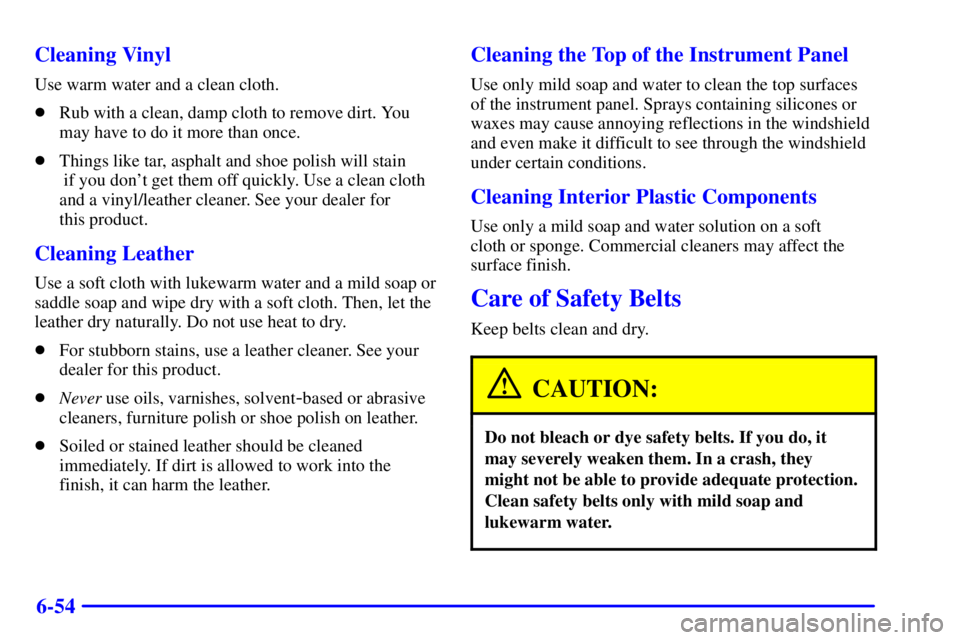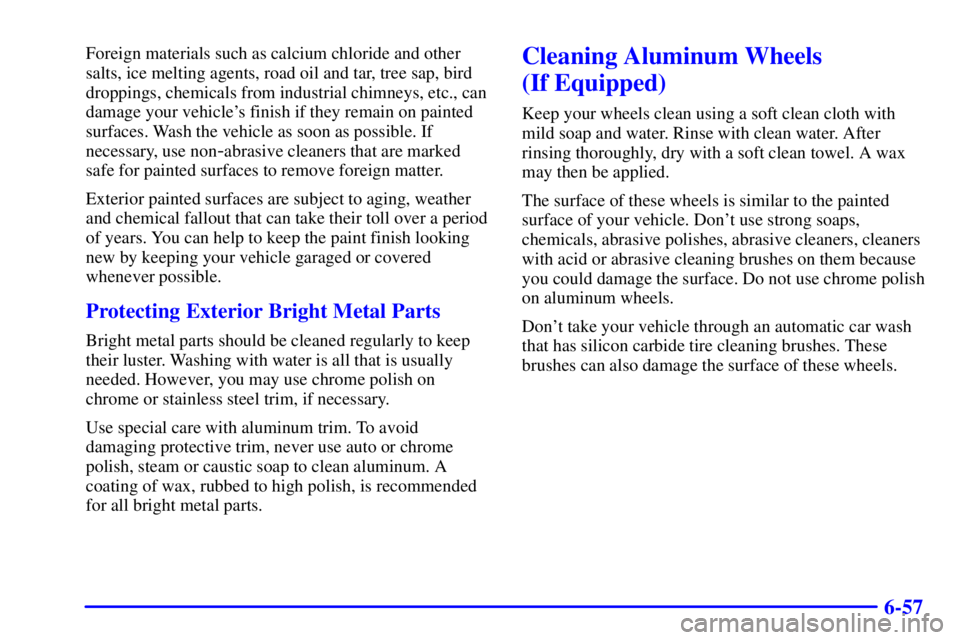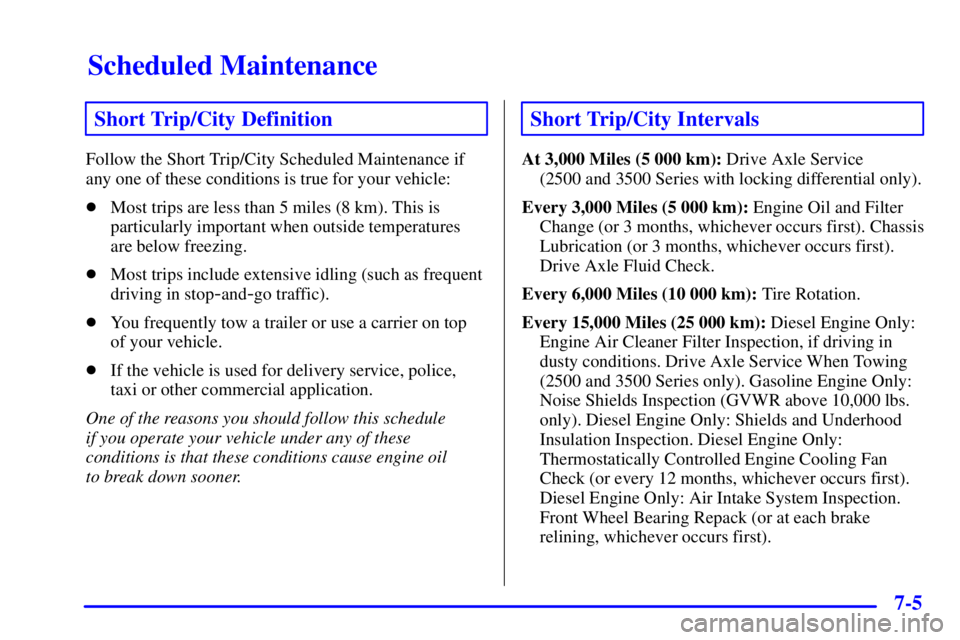Page 321 of 411

6-54 Cleaning Vinyl
Use warm water and a clean cloth.
�Rub with a clean, damp cloth to remove dirt. You
may have to do it more than once.
�Things like tar, asphalt and shoe polish will stain
if you don't get them off quickly. Use a clean cloth
and a vinyl/leather cleaner. See your dealer for
this product.
Cleaning Leather
Use a soft cloth with lukewarm water and a mild soap or
saddle soap and wipe dry with a soft cloth. Then, let the
leather dry naturally. Do not use heat to dry.
�For stubborn stains, use a leather cleaner. See your
dealer for this product.
�Never use oils, varnishes, solvent
-based or abrasive
cleaners, furniture polish or shoe polish on leather.
�Soiled or stained leather should be cleaned
immediately. If dirt is allowed to work into the
finish, it can harm the leather.
Cleaning the Top of the Instrument Panel
Use only mild soap and water to clean the top surfaces
of the instrument panel. Sprays containing silicones or
waxes may cause annoying reflections in the windshield
and even make it difficult to see through the windshield
under certain conditions.
Cleaning Interior Plastic Components
Use only a mild soap and water solution on a soft
cloth or sponge. Commercial cleaners may affect the
surface finish.
Care of Safety Belts
Keep belts clean and dry.
CAUTION:
Do not bleach or dye safety belts. If you do, it
may severely weaken them. In a crash, they
might not be able to provide adequate protection.
Clean safety belts only with mild soap and
lukewarm water.
Page 324 of 411

6-57
Foreign materials such as calcium chloride and other
salts, ice melting agents, road oil and tar, tree sap, bird
droppings, chemicals from industrial chimneys, etc., can
damage your vehicle's finish if they remain on painted
surfaces. Wash the vehicle as soon as possible. If
necessary, use non
-abrasive cleaners that are marked
safe for painted surfaces to remove foreign matter.
Exterior painted surfaces are subject to aging, weather
and chemical fallout that can take their toll over a period
of years. You can help to keep the paint finish looking
new by keeping your vehicle garaged or covered
whenever possible.
Protecting Exterior Bright Metal Parts
Bright metal parts should be cleaned regularly to keep
their luster. Washing with water is all that is usually
needed. However, you may use chrome polish on
chrome or stainless steel trim, if necessary.
Use special care with aluminum trim. To avoid
damaging protective trim, never use auto or chrome
polish, steam or caustic soap to clean aluminum. A
coating of wax, rubbed to high polish, is recommended
for all bright metal parts.
Cleaning Aluminum Wheels
(If Equipped)
Keep your wheels clean using a soft clean cloth with
mild soap and water. Rinse with clean water. After
rinsing thoroughly, dry with a soft clean towel. A wax
may then be applied.
The surface of these wheels is similar to the painted
surface of your vehicle. Don't use strong soaps,
chemicals, abrasive polishes, abrasive cleaners, cleaners
with acid or abrasive cleaning brushes on them because
you could damage the surface. Do not use chrome polish
on aluminum wheels.
Don't take your vehicle through an automatic car wash
that has silicon carbide tire cleaning brushes. These
brushes can also damage the surface of these wheels.
Page 334 of 411
6-67
NAME CIRCUITS PROTECTED
ETC Electronic Throttle Control
RR BLOWER Rear Auxiliary Blower
Motor Relays
CNG Compressed Natural Gas
ENG
-I Heated O2 Sensors, Mass Air
Flow Sensor, Evap Canister Purge
Valve, Crankshaft Position Sensor,
Secondary Air Injection Relay
(Diesel), Water in Fuel Sensor
(Diesel), Fuel Heater (Diesel),
Glowplug Relay (Diesel),
Wastegate Solenoid (Diesel)
ECM
-I Ignition Coil, Camshaft Position
Sensor, VCM, Fuel Injectors,
Coil Driver
IGN
-E Air Conditioning Clutch Relay
SPARE Spare Fuse
SPARE Spare Fuse
SPARE Spare FuseNAME CIRCUITS PROTECTED
A/C Air Conditioning Clutch Relay
HORN Horn Relay, Underhood Lamp(s)
ECM
-B Fuel Pump Relay, VCM, PCM,
Fuel Pump and Engine Oil
Pressure Switch
SPARE Spare Fuse
SPARE Spare Fuse
AUX A Upfitter Provisions
AUX B Upfitter Provisions
A/C RELAY Air Conditioning
HORN RELAY Horn
A.I.R. RELAY Air
FUEL
PUMP RELAYFuel Pump
STARTER
RELAYStarter
ABS EXPORT
RELAYABS Export
Page 337 of 411
6-70 Wheel Nut Torque
MODEL TORQUE
All
140 lb
-ft (190 N´m)
Cooling System Capacity
ENGINE VIN QTY Without Rear Heater QTY With Rear Heater
ªVORTECº 4300 V6 W 11.0 quarts (10.4 L) 14.0 quarts (13.2 L)
ªVORTECº 5000 V8 M 17.0 quarts (16.0 L) 20.0 quarts (18.9 L)
ªVORTECº 5700 V8 R 17.0 quarts (16.0 L) 20.0 quarts (18.9 L)
ªVORTECº 8100 V8 G 23.0 quarts (21.8 L) 26.0 quarts (24.6 L)
After refill, the level MUST be checked as outlined under ªEngine Cooling Systemº in Section 5.
Engine Oil Capacity
ENGINE VIN Quantity
ªVORTECº 4300 V6 W 4.5 quarts (4.3 L)
ªVORTECº 5000 V8 M 5.0 quarts (4.8 L)
ªVORTECº 5700 V8 R 5.0 quarts (4.8 L)
ªVORTECº 8100 V8 G 6.5 quarts (6.15 L)
Page 339 of 411

6-72
Normal Maintenance Replacement Parts
Replacement Parts
Replacement part numbers listed in this section are based on the latest information available at the time of printing,
and are subject to change. If a part listed in this manual is not the same as the part used in your vehicle when it was
built, or if you have any questions, please contact your GM dealer.
These specifications are for information only. If you have any questions, see the service manual for the chassis or
refer to the body manufacturer's publications.
EngineªVORTECº 4300
V6ªVORTECº 5000
V8ªVORTECº 5700
V8ªVORTECº8100
V8
VIN W M R G
Oil Filter PF47 PF1218 PF1218 PF454
Engine Air Cleaner Filter * A917C A917C A917C A917C
PCV Valve CV769C CV769C CV769C **
Spark Plugs
41
-932 41-932 41-932 TJ14R-P15
Fuel Filter GF481 GF481 GF481 GF481
Radiator Cap RC36 RC36 RC36 RC36
* Replace with ACDelco
� Air Filter, Part No. A917C and for severe dusty conditions, use ACDelco� Air Filter,
Part No. 1236C.
**8100 V8 has an internal PCV which does not require replacement.
Page 344 of 411

Scheduled Maintenance
7-5
Short Trip/City Definition
Follow the Short Trip/City Scheduled Maintenance if
any one of these conditions is true for your vehicle:
�Most trips are less than 5 miles (8 km). This is
particularly important when outside temperatures
are below freezing.
�Most trips include extensive idling (such as frequent
driving in stop
-and-go traffic).
�You frequently tow a trailer or use a carrier on top
of your vehicle.
�If the vehicle is used for delivery service, police,
taxi or other commercial application.
One of the reasons you should follow this schedule
if you operate your vehicle under any of these
conditions is that these conditions cause engine oil
to break down sooner.
Short Trip/City Intervals
At 3,000 Miles (5 000 km): Drive Axle Service
(2500 and 3500 Series with locking differential only).
Every 3,000 Miles (5 000 km): Engine Oil and Filter
Change (or 3 months, whichever occurs first). Chassis
Lubrication (or 3 months, whichever occurs first).
Drive Axle Fluid Check.
Every 6,000 Miles (10 000 km): Tire Rotation.
Every 15,000 Miles (25 000 km): Diesel Engine Only:
Engine Air Cleaner Filter Inspection, if driving in
dusty conditions. Drive Axle Service When Towing
(2500 and 3500 Series only). Gasoline Engine Only:
Noise Shields Inspection (GVWR above 10,000 lbs.
only). Diesel Engine Only: Shields and Underhood
Insulation Inspection. Diesel Engine Only:
Thermostatically Controlled Engine Cooling Fan
Check (or every 12 months, whichever occurs first).
Diesel Engine Only: Air Intake System Inspection.
Front Wheel Bearing Repack (or at each brake
relining, whichever occurs first).
Page 346 of 411

Scheduled Maintenance
7-7
Long Trip/Highway Definition
Follow this scheduled maintenance only if none of
the conditions from the Short Trip/City Scheduled
Maintenance are true. Do not use this schedule if the
vehicle is used for trailer towing, driven in a dusty
area or used off paved roads. Use the Short Trip/City
schedule for these conditions.
Driving a vehicle with a fully warmed engine under
highway conditions will cause engine oil to break
down slower.
Long Trip/Highway Intervals
At 7,500 Miles (12 500 km): Drive Axle Service
(2500 and 3500 Series with locking differential only).
Every 7,500 Miles (12 500 km): Engine Oil and Filter
Change (or every 12 months, whichever occurs first).
Chassis Lubrication (or every 12 months, whichever
occurs first). Drive Axle Fluid Check. Tire Rotation.
Every 15,000 Miles (25 000 km): Gasoline Engine
Only: Noise Shields Inspection (GVWR above
10,000 lbs. only). Diesel Engine Only: Shields
and Underhood Insulation Inspection. Diesel Engine
Only: Thermostatically Controlled Engine Cooling
Fan Check (or every 12 months, whichever
occurs first). Diesel Engine Only: Air Intake
System Inspection.
Page 349 of 411
Short Trip/City Scheduled Maintenance
7-10
3,000 Miles (5 000 km)
�Change engine oil and filter (or every 3 months, whichever occurs first).
An Emission Control Service.
�Lubricate chassis components (or every 3 months, whichever occurs first).
(See footnote #.)
�Check axle fluid level and add fluid as needed. 2500 and 3500 Series Only:
If your vehicle has a locking differential, drain fluid and refill at first engine
oil change.
6,000 Miles (10 000 km)
�Change engine oil and filter (or every 3 months, whichever occurs first).
An Emission Control Service.
�Lubricate chassis components (or every 3 months, whichever occurs first).
(See footnote #.)
�Check axle fluid level and add fluid as needed.
�Rotate tires. See ªTire Inspection and Rotationº in the Index for proper
rotation pattern and additional information. (See footnote +.)
ACTUAL
SERVICED BY:MILEAGE
DATE
ACTUAL
SERVICED BY:MILEAGE
DATE